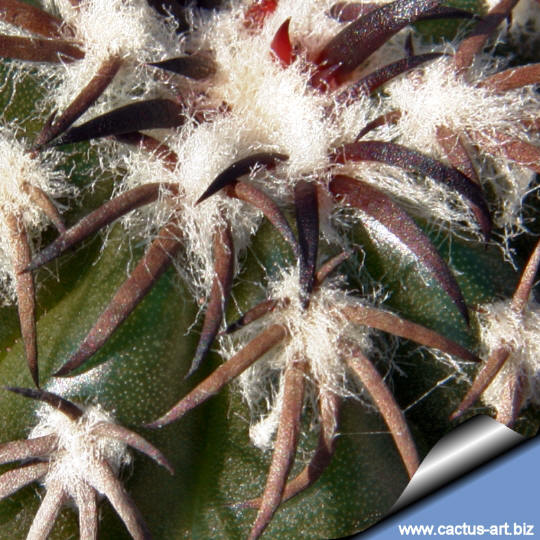|
|
Family:
Cactaceae (Cactus
Family)
Scientific name: Discocactus hybrid
(D. horstii x D. crystallophilus)
Origin:
Garden origin (Nursery
produced cultivar)Parents:
- Discocactus crystallophilus Diers
& Esteves
In: Kakteen Sukk. 32(11):258. 1981
-
Discocactus horstii Buining &
Brederoo
Published
in Krainz Die Kakteen C VI f-1/1973
Subfamily: Cactoideae
tribe: Trichocereeae.
Conservation status: Listed in
CITES appendix 1.
|
|
Description: Plants of this
genus are relatively easy to cross-pollinate and hybridize. Some species
hybridize easily while some not. One much sought after result is to
cross
D. horstii and
D. christallophylus in order to produce a plant that would
have the intensely coloured epidermis and pronounced rib structure with
short pines of the former and the intense floral fragrance of the
latter. This is a strong plant that form a white
cephalium at maturity, and that - with good treatment - should
flower on and off throughout the year. This hybrid produces flowers in
great profusion.
Stem: Solitary, flattened globose or shaped like a cake up to 6
cm tall, 10 cm in diameter. The epidermis is tannish-green to dark
brownish-green.
Flowers: Nocturnal, very fragrant up to 7-8 cm long, 6 cm in
diameter.
Blooming season: Flowers come in profusion in summer, out of the
cephalium.
Spines: 5-7 (or more) light coloured (brown to reddish when
very young) recurved backwards in a comb like arrangement, 4-10 mm
long.
|
|
|
|

Cultivation: Collectors
consider this cactus genus from South America to be rarities as they are
not the easiest plant to keep happy. it is rather difficult to grow and
frost tender, should be kept at above 15° C if grown on its own roots
(8°C if grafted) need full sun or afternoon shade. Young seedlings are
generally grafted because they are slow growing and very rot prone when
kept on their own roots and though they can’t endure long stretches of
total dryness, too much water will rot them, as their weak root systems
tend to be inefficient at sucking up water from wet soil. They generally
resent being repotted and can take a long time to establish.
Propagation: Seed. Young
seedlings are often grafted on a low stock to keep the plant in a good
shape.


|
|